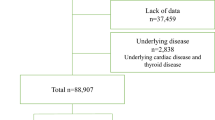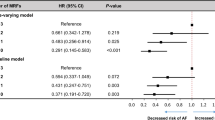Abstract
Prediction models of atrial fibrillation (AF) have been developed; however, there was no AF prediction model validated in Chinese population. Therefore, we aimed to investigate the incidence of AF in urban Han Chinese health check-up population, as well as to develop AF prediction models using behavioral, anthropometric, biochemical, electrocardiogram (ECG) markers, as well as visit-to-visit variability (VVV) in blood pressures available in the routine health check-up. A total of 33 186 participants aged 45–85 years and free of AF at baseline were included in this cohort, to follow up for incident AF with an annually routine health check-up. Cox regression models were used to develop AF prediction model and 10-fold cross-validation was used to test the discriminatory accuracy of prediction model. We developed three prediction models, with age, sex, history of coronary heart disease (CHD), hypertension as predictors for simple model, with left high-amplitude waves, premature beats added for ECG model, and with age, sex, history of CHD and VVV in systolic and diabolic blood pressures as predictors for VVV model, to estimate risk of incident AF. The calibration of our models ranged from 1.001 to 1.004 (P for Hosmer Lemeshow test >0.05). The area under receiver operator characteristics curve were 78%, 80% and 82%, respectively, for predicting risk of AF. In conclusion, we have identified predictors of incident AF and developed prediction models for AF with variables readily available in routine health check-up.


Similar content being viewed by others
References
Zoni-Berisso M, Lercari F, Carazza T, Domenicucci S . Epidemiology of atrial fibrillation: European perspective. Clin Epidemiol 2014; 6: 213–220.
Chugh SS, Havmoeller R, Narayanan K, Singh D, Rienstra M, Benjamin EJ et al. Worldwide epidemiology of atrial fibrillation: a Global Burden of Disease 2010 Study. Circulation 2014; 129 (8): 837–847.
Murphy NF, Simpson CR, Jhund PS, Stewart S, Kirkpatrick M, Chalmers J et al. A national survey of the prevalence, incidence, primary care burden and treatment of atrial fibrillation in Scotland. Heart 2007; 93 (5): 606–612.
Furberg CD, Psaty BM, Manolio TA, Gardin JM, Smith VE, Rautaharju PM . Prevalence of atrial fibrillation in elderly subjects (the Cardiovascular Health Study). Am J Cardiol 1994; 74 (3): 236–241.
Heeringa J, van der Kuip DA, Hofman A, Kors JA, van Herpen G, Stricker BH et al. Prevalence, incidence and lifetime risk of atrial fibrillation: the Rotterdam study. Eur Heart J 2006; 27 (8): 949–953.
Wheeldon NM, Tayler DI, Anagnostou E, Cook D, Wales C, Oakley GD . Screening for atrial fibrillation in primary care. Heart 1998; 79 (1): 50–55.
Chei CL, Raman P, Ching CK, Yin ZX, Shi XM, Zeng Y et al. Prevalence and risk factors of atrial fibrillation in Chinese elderly: results from the chinese longitudinal healthy longevity survey. Chinese Med J 2015; 128 (18): 2426–2432.
Guo Y, Tian Y, Wang H, Si Q, Wang Y, Lip GY . Prevalence, incidence, and lifetime risk of atrial fibrillation in China: new insights into the global burden of atrial fibrillation. Chest 2015; 147 (1): 109–119.
Schnabel RB, Sullivan LM, Levy D, Pencina MJ, Massaro JM, D'Agostino RB et al. Development of a risk score for atrial fibrillation (Framingham Heart Study): a community-based cohort study. Lancet 2009; 373 (9665): 739–745.
Alonso A, Krijthe BP, Aspelund T, Stepas KA, Pencina MJ, Moser CB et al. Simple risk model predicts incidence of atrial fibrillation in a racially and geographically diverse population: the CHARGE-AF consortium. J Am Heart Assoc 2013; 2 (2): e000102.
Kolek MJ, Graves AJ, Xu M, Bian A, Teixeira PL, Shoemaker MB et al. Evaluation of a prediction model for the development of atrial fibrillation in a repository of electronic medical records. JAMA Cardiol 2016; 1 (9): 1007–1013.
Chobanian AV, Bakris GL, Black HR, Cushman WC, Green LA, Izzo JL Jr. et al. Seventh report of the Joint National Committee on Prevention, Detection, Evaluation, and Treatment of High Blood Pressure. Hypertension 2003; 42 (6): 1206–1252.
Yuan X, Liu T, Wu L, Zou ZY, Li C . Validity of self-reported diabetes among middle-aged and older Chinese adults: the China Health and Retirement Longitudinal Study. BMJ Open 2015; 5 (4): e006633.
Mb RJP, Crow RS, Zhang Z-M . The Minnesota Code Manual of Electrocardiographic Findings. Springer: London, UK, 2010.
O'Neal WT, Venkatesh S, Broughton ST, Griffin WF, Soliman EZ . Biomarkers and the prediction of atrial fibrillation: state of the art. Vasc Health Risk Manag 2016; 12: 297–303.
Vilchez JA, Roldan V, Hernandez-Romero D, Valdes M, Lip GY, Marin F . Biomarkers in atrial fibrillation: an overview. Int J Clin Pract 2014; 68 (4): 434–443.
Lau YF, Yiu KH, Siu CW, Tse HF . Hypertension and atrial fibrillation: epidemiology, pathophysiology and therapeutic implications. J Hum Hypertens 2012; 26 (10): 563–569.
Milan A, Caserta MA, Dematteis A, Naso D, Pertusio A, Magnino C et al. Blood pressure levels, left ventricular mass and function are correlated with left atrial volume in mild to moderate hypertensive patients. J Hum Hypertens 2009; 23 (11): 743–750.
Vlachos K, Letsas KP, Korantzopoulos P, Liu T, Georgopoulos S, Bakalakos A et al. Prediction of atrial fibrillation development and progression: current perspectives. World J Cardiol 2016; 8 (3): 267–276.
Anumonwo JM, Kalifa J . Risk factors and genetics of atrial fibrillation. Cardiol Clin 2014; 32 (4): 485–494.
Sabayan B, Wijsman LW, Foster-Dingley JC, Stott DJ, Ford I, Buckley BM et al. Association of visit-to-visit variability in blood pressure with cognitive function in old age: prospective cohort study. BMJ (Clin Res Ed) 2013; 347: f4600.
Gavriilaki E, Gkaliagkousi E, Douma S . Visit-to-visit blood pressure variability: more to come. J Clin Hypertens (Greenwich) 2015; 17 (2): 116–117.
Rautaharju PM, Soliman EZ . Electrocardiographic left ventricular hypertrophy and the risk of adverse cardiovascular events: a critical appraisal. J Electrocardiol 2014; 47 (5): 649–654.
Chamberlain AM, Agarwal SK, Folsom AR, Soliman EZ, Chambless LE, Crow R et al. A clinical risk score for atrial fibrillation in a biracial prospective cohort (from the Atherosclerosis Risk in Communities [ARIC] study). Am J Cardiol 2011; 107 (1): 85–91.
Gladstone DJ, Dorian P, Spring M, Panzov V, Mamdani M, Healey JS et al. Atrial premature beats predict atrial fibrillation in cryptogenic stroke: results from the EMBRACE trial. Stroke 2015; 46 (4): 936–941.
Alonso A, Roetker NS, Soliman EZ, Chen LY, Greenland P, Heckbert SR . Prediction of atrial fibrillation in a racially diverse cohort: the Multi-Ethnic Study of Atherosclerosis (MESA). J Am Heart Assoc 2016; 5 (2): e003077.
D'Agostino RB Sr, Grundy S, Sullivan LM, Wilson P . Validation of the Framingham coronary heart disease prediction scores: results of a multiple ethnic groups investigation. Jama 2001; 286 (2): 180–187.
Thomsen TF, McGee D, Davidsen M, Jorgensen T . A cross-validation of risk-scores for coronary heart disease mortality based on data from the Glostrup Population Studies and Framingham Heart Study. Int J Epidemiol 2002; 31 (4): 817–822.
Liu J, Hong Y, D'Agostino RB Sr, Wu Z, Wang W, Sun J et al. Predictive value for the Chinese population of the Framingham CHD risk assessment tool compared with the Chinese Multi-Provincial Cohort Study. JAMA 2004; 291 (21): 2591–2599.
Hense HW, Schulte H, Lowel H, Assmann G, Keil U . Framingham risk function overestimates risk of coronary heart disease in men and women from Germany—results from the MONICA Augsburg and the PROCAM cohorts. Eur Heart J 2003; 24 (10): 937–945.
Acknowledgements
This work was supported by National Natural Science Foundation of China, China (81273177) and Shandong health management league on risk prediction and personalizes intervention. The founders were not involved in study design, analysis and interpretation. We thank all subjects who participated in the study.
Author information
Authors and Affiliations
Corresponding author
Ethics declarations
Competing interests
The authors declare no conflict of interest.
Additional information
Supplementary Information accompanies this paper on the Journal of Human Hypertension website
Supplementary information
Rights and permissions
About this article
Cite this article
Ding, L., Li, J., Wang, C. et al. Incidence of atrial fibrillation and its risk prediction model based on a prospective urban Han Chinese cohort. J Hum Hypertens 31, 574–579 (2017). https://doi.org/10.1038/jhh.2017.23
Received:
Revised:
Accepted:
Published:
Issue Date:
DOI: https://doi.org/10.1038/jhh.2017.23
- Springer Nature Limited
This article is cited by
-
Blood pressure, hypertension and the risk of atrial fibrillation: a systematic review and meta-analysis of cohort studies
European Journal of Epidemiology (2023)




